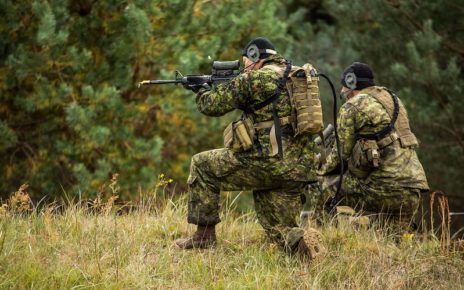Touraj Riazi had the great privilege of interviewing former director of the Missile Defense Agency Lt. General (Ret’d) Patrick O’Reilly. Lt. Gen. O’Reilly enjoyed a lengthy and distinguished career in the Army where he occupied a variety of positions including Program Manager for the Directed Energy Programs, Patriot Missile PAC 3, THAAD, and the Ground based Midcourse Defense Program. Lt. Gen. O’Reilly culminated his career with being appointed Director of the MDA from 2008-2012.
Describe opportunities in the future of BMDS (Ballistic Missile Defense System), specifically the integration of solid state lasers (SSL) with unmanned aerial vehicles (UAV)?
We invested a lot in the terrestrial and sea based BMD systems. However, the opportunities of using UAV’s as BMD platforms is what missile defense needs to leverage for the future.
UAVs are flying higher and longer with larger payloads. This progress in aviation technology offers an exciting opportunity for missile defence. Not only from putting sensors up there, not only adding nodes to communication but UAVs also reduce the reliance on space based assets. And, space based assets- putting things up in space to do missile defence functions- are obviously the most expensive alternative.
If you look at future technology, orbiting systems that predictably circumnavigate the earth become more, and more, vulnerable over time as other countries develop anti-satellite technologies with greater and greater ranges. Space systems are by their nature expensive and there are sensors on board that need to be very accurate. I’m not saying don’t do it, but it’s the most expensive option.
I think we are approaching an era of leveraging the latest advancement in aviation which is UAVs. UAVs can fly predictable patterns or can fly using artificial intelligence. Thus, if you lose communications with them they are still preprogrammed to do what they are supposed to do.
Most of BMDS components are dormant 99.9 % of their operating lives, so you could integrate BMDS functions with other functions that UAVs could do for the military, to support all the other military functions that UAVs do. So UAVs are very nice platforms for combining missile defence with other functions.
At the same time, we have learned from our experience with lasers that Solid-State Lasers (SSLs) are becoming more powerful and compact. And what is really important, is that the higher you fly, and UAVs give you that opportunity, the thinner the earth’s atmosphere is and less complex beam propagation systems are required.
You know, when we build ABL (Airborne Laser System) a large part of the investment and development of the laser system on that 747 was in the optical system. And that was an optical system designed to very precisely track and compensate for the earth’s atmosphere at the altitudes it flew. But, if you fly at much higher altitudes, then you do not have as much of the atmosphere to deal with and you can use much smaller beam pointing and atmospheric compensations systems.
So the concept of ABL was developed in the 90’s and it’s predecessors were developed in the 70’s and 80’s. Since then, UAVs have been developed to fly extremely high for long periods of time.
Now that we have high altitude UAVs, on-board laser beams can propagate farther and with less power required to propagate through a thin atmosphere. A vulnerability of a long range offensive missile is that if it’s going to be effective, it needs to fly accurately. However, the tolerances for an offensive missile are not as strict as a defensive missile, which has to hit an object the size of a warhead. If you’re trying to hit a power plant or a military base, you have a much bigger target and the missile doesn’t have to be as precise, but you still need to fly with some level of precision.
If you’re trying to destroy a missile with a laser, which we have done, a lot of power is needed to destroy the missile. However, if you are trying to disrupt, interfere, or harass, a missile so that the offence knows it does not have the same confidence that the missile is going to strike the target they are shooting at, then you can use much lower power lasers.
When you add all that up we are approaching a point today where we are looking at the releases of the amount of power that you read in the press releases for the SSL and their size.
Equally important as the development of solid state lasers is the advancement in energy storage in the automotive and solar industries. They have invested billions of dollars in researching power storage and conditioning. The progress in those enabling capabilities allow one to conclude that technology is very close to allowing the integration of high-power SSL’s with UAVs.
I have no knowledge of any specific SSL or UAV program, but just by looking at the status of technologies attractive for integrating BMDS packages on UAVs, it is easy to conclude that they would provide very cost-effective anti-missile technology. Additionally, you don’t have geopolitical issues if you are only deploying UAVs to patrol the earth’s oceans and costal areas where if you previously had to deploy ships, or if you had to deploy ground based BMDS, and negotiate treaties with countries, it becomes very expensive.
This goes back to some of my earlier comments about how do you calculate the cost of a missile defence system, and I think UAVs and modern technologies- not only of lasers, but energy storage work that’s going on from the commercial side- have taken us to a point where it’s extremely attractive to pursue the integration of UAV and BMDS technologies.
Is diminishing the reliance on space based technologies and radars like the STSS a function of developing technologies in both aircraft and lasers or was reducing reliance on space a specific driver of those developments?
I’m unaware that it was a driver. It’s more of an emerging opportunity. When you look over the past 20 years at missile defence technologies, and the architecture, UAVs never played a prominent role. During my service in government we had a tendency to attribute our military technical progress with what we chose to invest in. That is a very narrow view. We have to open our aperture of consideration to technologies that somebody else developed for other purposes.
They constantly use the term dual purpose, but a lot of times that dual purpose was not readily recognized. And, frankly, the investments on the commercial side today are so much higher in technology than what the Pentagon does on the R&D side. If you’re going to have the most cost effective BMDS possible, you really need to be investing as large an effort into harvesting technologies that were developed by somebody else for other commercial purposes because they really have eclipsed the work that DOD would have done.
Industrial lasers are driving the SSL development, it’s not defence. It’s the solar, the automotive industry, that’s developing power storage, light weight, extremely high power density, and equally important power conditioning – which means you can precisely manage the on-board power and the software processors to enable the next generation of BMD. Obviously the commercial processor industry is investing by many orders of magnitude more than DOD (Department of Defence) in new R&D.
So I don’t think the current focus on UAVs was intentionally done to reduce the reliance on space. I think it was more of we stumbled into it and realized we are under-investing in UAV applications. So, the decisions that have to be made are really about budget balance. How much are you going to invest in ground based, sea-based, space-based and aviation based lasers and sensors. It has to be a balance. But, the area that I think has had the least amount of investment in over the past decade, compared to its technical progress, is UAVs.
What are your views on mobile laser platforms, in sea or space, and do you think it would be preferable to have space based, ground based, or air to air power supplying units?
Space launch capabilities are continually being developed and the cost continues to come down. Even at their most optimistic cost, its an order of magnitude more expensive to put power systems in space instead of on aviation platforms. Likewise, aviation platforms are much more expensive than ground-based ones. So I think the real consideration goes back to basic science and it’s the advantages of operating in the earth’s high atmosphere.
If you’re operating a laser on the ground, you unfortunately do need a tremendous amount of power. I see lasers being deployed on ships today and that makes perfect sense because you have a big ship engine, with a lot of power, to power the laser. However, the beam propagation distances are not that great because the laser has to burn through the earth’s dense low atmosphere.
Thick atmospheres also scatters a laser beam, so you need to incorporate adaptive optics, and all the tricks that we have learned over the years, so that the beam is perfectly focused at the intended point, in the path of the beam over a great distance. The use of adaptive optical to accomplish that requirement are well known and unclassified.
Just look at what astronomy has gone through in the past decades. The idea of forming beams at a great distance is basic physics. The nice thing about UAVs are, if you can get them high enough, they have the advantages of operating in a thin atmosphere, but they don’t have the expense or vulnerability of operating in space. That vulnerability is not just a threat having a new weapon that could shoot down our satellites with lasers and things. I’m referring to the vulnerability that was just demonstrated a decade ago when the Chinese shot down their own satellite and caused it to orbit large debris fields.
The moving “Gravity” that was built around that debris pattern is a real threat to all objects in space. So, I’m not saying UAVs are a replacement for space based components, I’m just saying that these advantages justify a lot investment, and this has to be taken into the calculus of determining how much is invested in different BMD platforms.
Are you in favour of having a UAV powered by artificial light as opposed to a solar powered UAV, given the differences in proven capability today, especially their sustainability and altitude requirements?
The number one focus from the technology point of view, is power density storage. How much power can you store in a small device?
The investments that Tesla has made have really been advantageous. They not only showed you could have an ability to store power that is orders of magnitude greater than it was in previous decades; but, also when they’re mass produced, you have great reliability and cost reduction. So dense power storage has become a real catalyst in opening up high powered systems to be placed on UAVs because they’re small.
Now the next question is, how do you provide that power to the storage device? You can either charge it up on the ground or you have the alternative, where advancements have been made in solar lined aircraft where all the space on the wings is exposed to the sun. Then the question becomes what is that rate of power charging and how much time do you have in order to sufficiently reach a charge? I don’t know the answers to that. But I do know we are making great progress.
What also needs to be taken into account is what is the total amount of charge / power you need, which directly relates to how many times you can shoot your laser. And if you want to be able to shoot your laser 40 or 50 times then you calculate the amount of power you need but are you going to do it all at once or can you trickle charge slowly? It doesn’t make sense to me why you would not send up UAVs that are fully charged, but then the question is can they recharge themselves.
This is where I think we are with cutting edge technology today on the commercial side. I’m not cognizant of all of the military projects that are going on but I do believe that it appears reasonable that this area is where you want to be investing. To get as much of a benefit as you can from the commercial investments and breakthroughs that have been made in power storage.
I do want to emphasize though, that I was not stating you would send up an aircraft that has no charge with it. What I’m saying is, you would fully charge those batteries and the size of those batteries would be driven by how many times you expect to shoot your laser before needing to recharge. And I don’t know the answers to that, but again, where we are venturing into this conversation is the great opportunity there is for these types of technologies to be applied today without significant development. It’s just harvesting and leveraging what has been done in industry, as long as you can convince industry to participate.
Can you explain what potential utilities of such a program would be, short of its conceived end? So assuming you don’t fully arrive at a stage where you could fully integrate UAV’s and SSL, do you think there is a benefit, in terms of communications or surveillance, in having a high altitude aircraft that is pretty much sedentary due to power requirements?
Well it is more of a platform that could perform any of the missile defence functions. You could also place command and control on board these UAVs.
And, as I said before, any BMDS is dormant for large periods of time. So the smartest application would be to integrate various missile defence functions, including C3, sensors and other functions that the military would need. For example, you could put a system that might be there for sea navigation purposes, atmospheric sensing, or other communications that have functions other than just purely missile defence.
I think that as missile defence continues to grow, one way of reducing the cost of missile defence is to integrate it with other military functions so that you’re not building single dedicated systems that only performs a missile defence function.
Photo: Lt. Gen. Patrick O’Reilly via Department of Defense. Public Domain.
Disclaimer: Any views or opinions expressed in articles are solely those of the authors and do not necessarily represent the views of the NATO Association of Canada.




